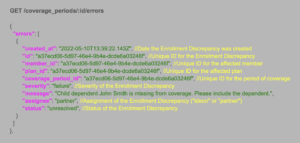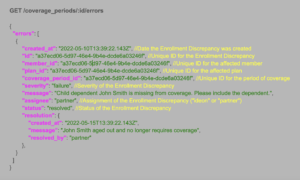At Ideon, we’re dedicated to facilitating seamless enrollments and data exchange for our carrier and benefits platform customers. That means not only maintaining the fast, accurate, and scalable connections they expect, but also providing greater transparency and visibility—qualities that have been lacking in our industry.
That’s why we’re excited to introduce a major enhancement to our product suite: the Ideon Dashboard, a powerful new interface that compliments our existing API endpoints. With enhanced monitoring of group implementation statuses and the ability to submit, track, and resolve issues, this dashboard brings unparalleled visibility, efficiency, and collaboration to Ideon’s enrollment customers.
The dashboard enables effective three-way collaboration between carriers, benefits platforms, and Ideon, allowing for the swift resolution of issues when they arise. It eliminates the clutter of email threads and ensures no issues are overlooked, all in a centralized, user-friendly tool that keeps all parties in the loop.
Let’s take a closer look at some of the key features.
Improved Visibility with the Enrollment Tasks Manager
Historically, setting up and managing group enrollments required numerous steps and lots of back-and-forth communication between carriers and benefits platforms. Ideon’s dashboard changes this equation. Carriers and platforms can now access real-time updates on the status of enrollment data that’s been loaded into Ideon’s system. This added visibility minimizes confusion and prevents potential delays in member enrollment.
At a glance, customers can get an immediate overview of their data across all groups, including details such as carrier-specific identifiers and coverage start and end dates. For each coverage period, they can monitor the status and owner of all completed and upcoming setup tasks.
Tasks can be assigned to specific users from the platform, Ideon, or the carrier, ensuring there’s alignment on next steps and responsibilities. Additionally, comments and attachments can be added to each task, providing necessary context and encouraging collaboration. This not only eliminates lengthy email exchanges but expedites the process of getting groups live.
Through the transparency and visibility provided by the Enrollment Tasks Manager, Ideon customers will always be informed about the status of their groups. They’ll have accurate and up-to-date information to share with members, brokers, and HR teams, ensuring a better enrollment experience with clear timelines and expectations.
Efficient Issue Resolution with the Customer Ticketing System
As carriers and benefits platforms’ operational teams know all too well, issues are bound to happen in our industry, whether it’s discrepant group information, a member inquiry, or another pressing matter.
The Ideon Dashboard offers streamlined issue resolution with its intuitive Customer Ticketing System. It centralizes communication and collaboration, allowing customers to easily submit, track, and resolve their questions, concerns, and escalations. With everything in one place, scattered communication channels like Slack and email are eliminated, and tickets are monitored right alongside the groups they belong to.
For each ticket, customers can provide notes, severity info, and useful attachments or documentation. Comment threads help maintain individualized communication with Ideon, and watcher functionality and email notifications keep customers in-the-know at all times.
Conclusion
The Ideon Dashboard is a powerful addition to Ideon’s enrollment solution, providing greater levels of visibility, efficiency, and collaboration to carriers and platforms—both during group setup and in production.
The new interface is designed to enhance the overall transparency and effectiveness of working with Ideon in a secure, centralized way. But it’s meant to complement, not replace Ideon’s suite of APIs.
All data and functionality offered by the dashboard are also available via Ideon’s existing API endpoints and webhooks. Using these features, our customers can seamlessly integrate status updates and other information into their own tooling and user experience. It’s all part of the unrivaled enrollment experience that Ideon delivers to our customers, their operations teams, and, ultimately, members, employers, and brokers.
Schedule a demo
The Ideon Dashboard has already seen great success among several of our carrier and benefits platform customers, and we can’t wait to show you all of its features. You can watch a short demo above, or reach out to schedule a personalized walkthrough.




